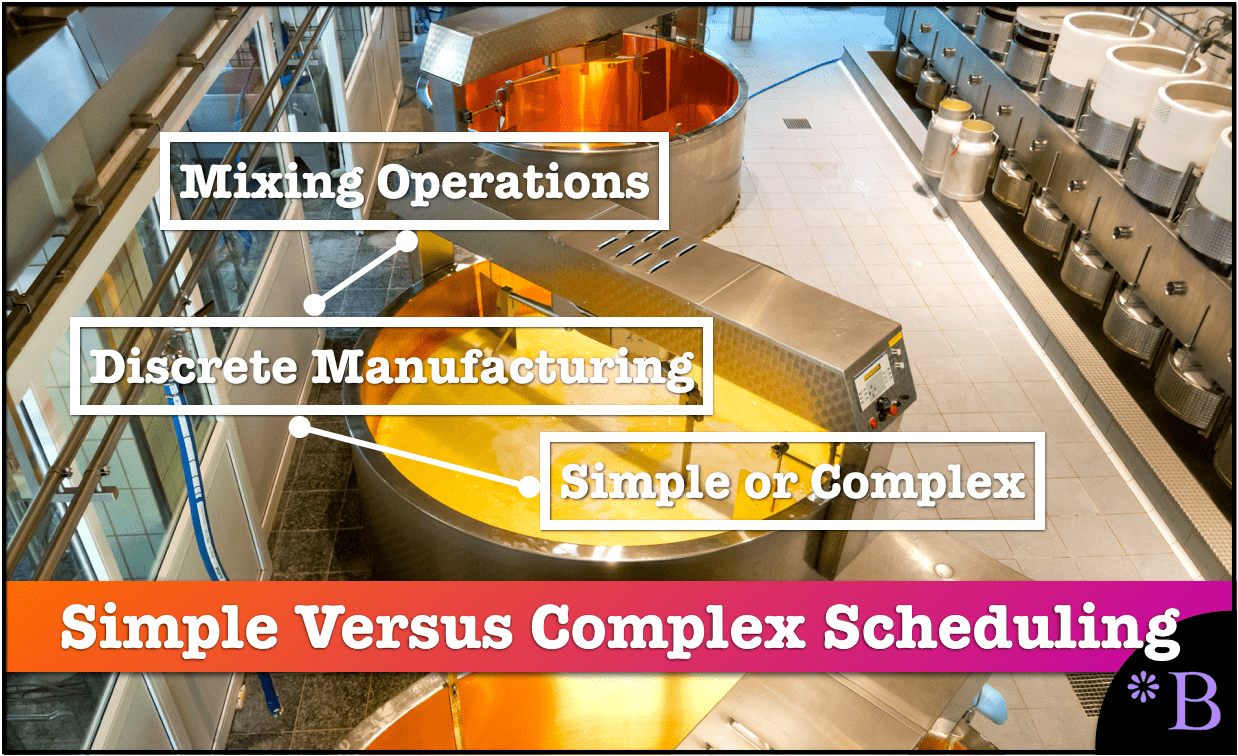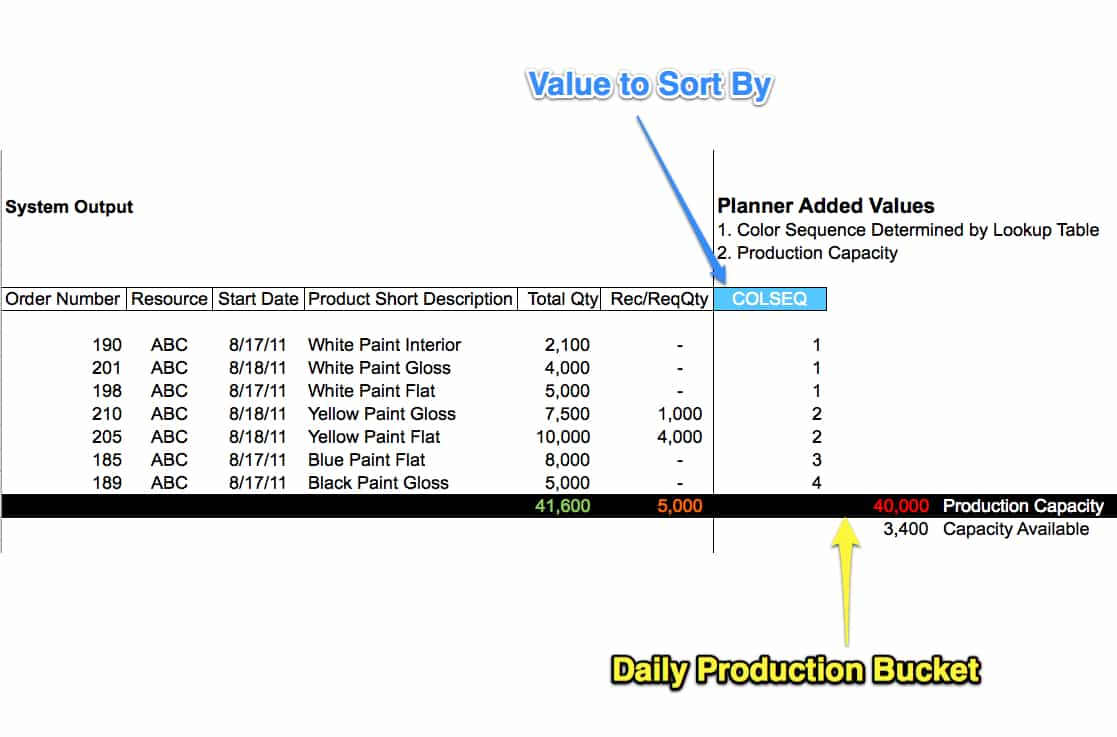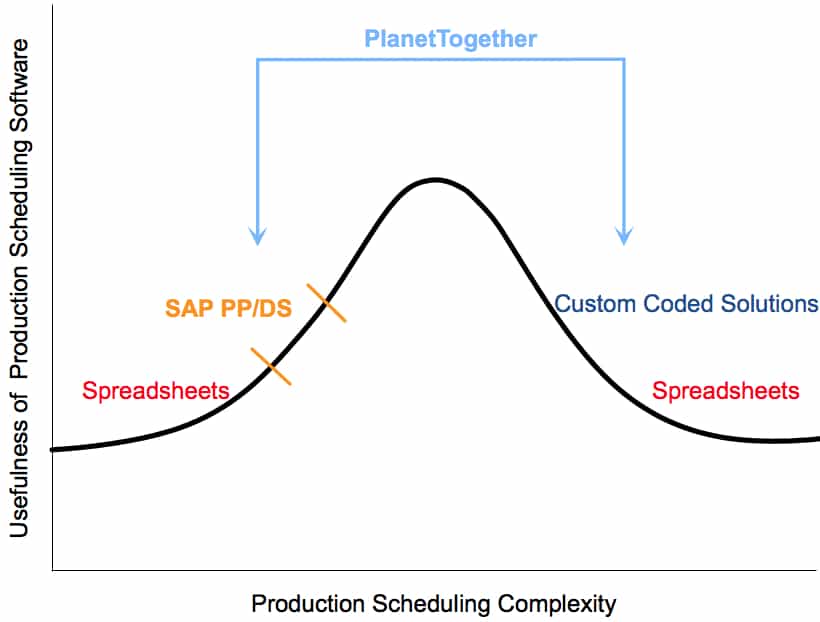Why Mixing Operations for Batch Production Can be Appropriate for Simple Production Scheduling Applications
Executive Summary
- Mixing operations for batch production tend to be little discussed, but they are a common manufacturing type.
- We cover mixing operations and mixing and blending operations.

Paint manufacturing and other mixing operations or mixing process like them do not have the same needs in production scheduling even though they are classified as process industry manufacturing.
Introduction
I am often placed on projects where I help troubleshoot the production scheduling systems from large vendors. The long story short on this is that the large vendors offer only the most basic production scheduling packages. Because discrete manufacturing was a more natural problem to solve, they developed their software to address that problem.
Batch Production
Paint mixing is one type of batch production. Batch production also applies to products like inks and pharmaceuticals and is where there is a changeover between different products. The term batch production is distinguished from the continuous output, where very long production runs are performed.
Process Industry Manufacturing Complexity
In several articles on this site, I have discussed that most process industry manufacturing is too complex for the scheduling applications put out by the major vendors.
I recently had an interesting experience at a process industry manufacturing client. I was surprised to learn that they were satisfied with the scheduling they performed solely with several enhancements to SAP ERP (that is not even the SAP PP/DS advanced planning scheduling application).
After speaking with them at some length, I learned some interesting things about their production process.
- There are no leading and lagging operations (much like discrete manufacturing)
- All materials are mixed in a mixer/vat
- All jobs can be completed in one day
An Example of a Simple Scheduling Problem
To demonstrate this principle, I have an example for one of the most simple production scheduling problems, that of a mixing operation or mixing process. According to Wikipedia, mixing is.
A unit operation that involves the manipulation of a heterogeneous physical system with the intent to make it more homogeneous)
A mixing tank is a tank with a mixer or agitator (generally on the top). When a mixing tank is used in a production process, it is called a mixing operation or mixing process and is scheduled just like any other production operation.
A blending operation is typically used to describe an activity where the materials have a robust quality. An excellent example of this is a blending powder.
Different Types of Mixing Tanks Including Liquid Mixer, the Chemical Mixer, Ribbon Mixer, and the Static Mixer
Mixing operation or mixing process is used for beverages, solvents, paints, adhesives, really a wide variety of liquid manufacturing and even non-liquid manufacturing.
- Mixing Tank: A mixing operation or mixing process relies upon a mixing tank, and there are many different types of a mixing tank, including a specialized chemical mixing tank known as a “chemical mixer,” a mixing tank for dairy, etc..
- Liquid Mixer: The most common mixing tank is the liquid mixing tank. The liquid mixer applies to, But the mixing tank is not limited to liquids.
- Static Mixer for Gas Mixing: Many plants use a static mixing tank or static mixer, mixing gas streams. A static mixer has a much more complex design than a liquid mixer. Most mixers are categorized as using a liquid mixer. A gas mixer or static mixer is considerably different than a liquid mixer and has different manufacturers. However, from a production scheduling perspective, all of the different types of mixing tanks are similar.
- Chemical Mixer: A chemical mixer is really just a special type of liquid mixer. It is used for a wide variety of industries. A chemical mixer is used for adhesives, agrochemicals, biofuels, drilling muds, inks, lube oils, paints and pigments, paper coatings, specialty chemicals, and much much more. A chemical mixer is the mixing equipment, but in the chemical industry, a chemical mixer is also a job description of the chemical mixer’s role.
- Ribbon Mixer: A ribbon mixer has blades that are in a spiral ribbon pattern. The ribbon mixer is sometimes used for liquids, but the ribbon mixer is actually more commonly used for blending. Ribbon mixers are often quite large and not computer-controlled.
The Powder Mixer, Ribbon Blender, and Powder Blending Machine
- Powder Mixer or Powder Blender: A power mixer or powder blender is explicitly designed for powders. Powder mixers and powder blenders can work on aggregate solids or excellent powders.
- Ribbon Blender: A ribbon blender is the same as a ribbon mixer, but it is designed for solids. A ribbon blender has blades that are in a spiral ribbon pattern. The ribbon blender is very commonly used in food processing.
- Powder Blending Machine: A powder blending machine is just another term for a powder mixer. Powder blending is common in chemical, food, pharmaceutical, minerals, and coating, and bonding.
This powder mixer video shows what a complete job a powder mixer does in mixing two different powders.
This is a vertical cone screw blender. Vertical blenders are one of the major categories of blenders.
Here is a high-cost powder mixer that is used by the pharmaceutical industry, among others. This powder mixer video shows how advanced some of these mixers are and how many powder mixers are computer-controlled. With computer control, the information from then can be integrated back to an MES system, which then connects to the production planning and scheduling system and, of course, the ERP system.
Here is an example of a ribbon blender. The primary use of this ribbon blender process that is shown is to mix some seasoning and some vegetable product over what appear to be chips.
The Mixing or Blending Operation or Mixing Process Problem
- A mixing or blending operation and the mixing process is a subcategory of the processing industry scheduling problem.
- Process industry scheduling issues are some of the most complex problems in manufacturing. However, a mixing operation or mixing process is a special subcategory.
- Mixing operation or mixing process problems defy manufacturing process complexity by being some of the most straightforward scheduling problems.

The scheduling process requires several steps, which can be emulated in something as simple as a spreadsheet using Excel’s sort function.
- Group orders that have close start dates
- Stop grouping the production orders once they approach the capacity for the day. The following formula shows this = Total Quantity for all Production Orders – Rec/ReqQty < Production Capacity (these colors match the variables in the screenshot) (Rec/ReqQty is the amount of the production order which has already been produced.)
- Run a VLOOKUP to assign a Color Sequence value to each prospective order
- Then run a sortation, just on the day that is scheduled
Multi-Stage Food Production
In multi-stage food production, there are situations where an intermediate is produced by a machine that directly feeds multiple other machines. The flow of material is direct (food transport may even be automatic between the equipment) and so the second stage machines are limited to producing output from the same intermediate at all points in time. For example, cookie dough might be blended in a blender which directly feeds two mold lines. Therefore when chocolate chip dough is finished blending and supplied to the mold lines, it’s not possible to mold chocolate chip cookies and sugar cookies simultaneously – the mold lines only have the chocolate chip dough to work with. APS.net can handle this constraint using the Compatible scheduling feature. APS.net would only allow the molders to schedule products simultaneously across the molders if they are Compatible – in this case, if they use the same intermediate dough. – Using APS.net for Effective Scheduling in the Food Processing Industry
PlanetTogether handles this by assigning resources to Compatibility Groups. Only resources that are part of the same Compatibility Group can run operations concurrently.
- Select the Compatibility Group to which the resource belongs in the Resource Properties
- The job operation must specify a Compatibility Code for the resources to be scheduled based upon the specific compatibility.
How to Best Match the Job Scheduling Problem Complexity to the Solution
The current and conventional thinking on the production schedule is that sophisticated software is required for it. There are a lot of examples where this is true. There seems to be a “sweet spot” where most “standard” advanced production scheduling software seems to apply from what I have seen. This is where the job scheduling problem is somewhat complex but not extremely complex. Secondly, different scheduling software will work or not work based upon where the problem is in terms of complexity and the type of schedule that is performed. This relationship is demonstrated by the graphic below:
This graphic reflects the relationship that packaged production scheduling software has a “sweet spot.” This is when a job scheduling problem is straightforward and very complex. This relationship also has an overlay with different applications. For instance, spreadsheets tend to be better for very simple or very complex problems.
However, within the scheduling software sweet spot, a weak production scheduling application like PP/DS has a narrow band that can be implemented successfully. I have, on several occasions, been brought onto PP/DS projects where PP/DS has failed to deliver value. This is because of incompetent configuration and a large consulting company that recommended the business PP/DS for an environment that PP/DS was never designed to handle. Executives will often spend several years trying to justify this decision, bringing in successive consultants rather than switching to a more appropriate solution.
PlanetTogether, on the other hand, is a best-of-breed application because it is a better solution than PP/DS, has a wide band of production scheduling problems over which it can be implemented. However, the band is not unlimited.
Custom Coded Solutions
These can be created using general optimization solvers. Because they are not preconfigured, they are highly customizable. For instance, I recently read about a custom production scheduling system designed for a smelting operation. However, the downside is that they are expensive and slow to develop, require specific skills to be successful, and have significant ongoing maintenance costs. The in-house support staff must maintain them. General optimization solvers include applications such as CPLEX or the optimizer to MATLAB. These are described in the post.
An example of how simple mixing scheduling is can be seen in this post.
Conclusion
Production scheduling encompasses many job scheduling problems, and some solutions are better fits than others within this continuum.
Production scheduling, as with many other areas of supply chain planning, is not a one-size-fits-all environment. This is true regardless of the intent and financial backing of the significant monopoly vendors like SAP and Oracle and all the major consulting companies who present the area this way. To make a good software selection, it is first necessary to analyze the job scheduling problem and the company’s specific detailed requirements and then compare them to the options that are the best fit for them. This type of due diligence is only very rarely performed, and for this reason, most companies have a production scheduling solution that does not fit their needs.
- Paint manufacturing meets the textbook definition of the process industry.
- The final product cannot be reasonably disassembled into its parts.
From the perspective of manufacturing complexity, paint manufacturing, and some others, a mixing and blending operation or mixing process is nowhere close to the proper level of sophistication in different manufacturing processes.
For instance, in many food processing environments, the duration of the production run depends on a multitude of factors, such as the temperature of the process. No such complexities impact paint manufacturing. A mixing and blending operation or mixing process is considerably easier to schedule than many discrete manufacturing environments. For this reason, they may be appropriate for the limited scheduling applications offered by the major vendors, even though they are technically part of process industry manufacturing.
For this reason, they may be appropriate for the limited scheduling applications offered by the major vendors, even though they are technically part of process industry manufacturing.
